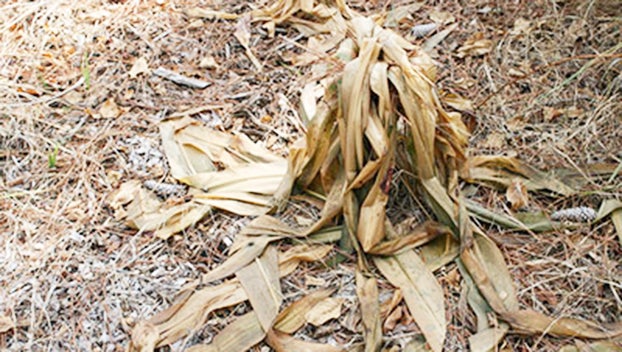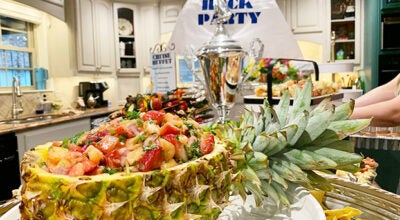MASTER GARDENER — Try this “Freezer Burn” cleanup strategy for help
Published 12:10 am Wednesday, January 4, 2023

- There is good reason for choosing not to immediately clean up the “freezer burned” plants throughout your landscape.
|
Getting your Trinity Audio player ready...
|
We have all now experienced an extended hard freeze that radiated throughout the entire country. For us the extremely cold temperatures left our landscapes looking grotesque, tattered and predominantly brow!
Gardeners, if your lawn and landscape looks even remotely like mine, let’s just say I’ve been a little mopey, because everything in my landscape was affected to some degree, though the most sensitive plants were thoroughly protected.
Forcing myself (patience), I’ve chosen not to immediately remove damaged plant material, but rather to wait before attempting landscape cleanup of any kind. I haven’t touched any of the many freeze-damaged trees, shrubs, or plants on my property.
But one thing each of us gardeners must do, if you haven’t already done so, is to remove protective covers from all plants immediately or more plant damage will certainly occur from over-heating and lack of photosynthesis!
The next step requires an immense amount of patience. There is good reason for choosing not to immediately clean up the “freezer burned” plants throughout your landscape.
Before explaining why waiting is best, before removing freeze-damaged plant parts, consider how we are to care for freeze-damaged plants. But first, let’s review precautionary steps to limit damage to our plants, reduce the work necessary to assist the plants’ recovery and mitigate freeze-damage in the future.
Tropical and subtropical plants have tender leaves and are highly susceptible to damage from cold weather but note all plants have a “cold” threshold, needing some protection from extreme cold.
For protection from cold weather, if plants can be moved, relocate them indoors or into a garage which can be heated. Or perhaps move them to a porch or patio, then completely cover each plant (top to bottom) with a light, cloth material, adding another outer layer of plastic over the cloth, to capture heat while retaining it near the plant.
Another option would be to enclose an existing porch or patio (temporarily) with plastic and add a space heater or light to increase the temperature.
Once plants are relocated to a protected area, make certain to water each of them thoroughly, as water acts as an insulator providing warmth to plant roots, and wet soil remains warmer than dry soil.
Many gardeners know but in case you’re new to gardening, in fall and winter adding a layer of mulch to plants will help to insulate their roots, protecting them while adding beneficial nutrients to the soil as the mulch breaks down over several months.
Leaves, grass clipping, pine straw, and hay each make great mulch when loosely applied 2 to 3-inches deep around the base of plants.
What are the some of the signs of “freezer burn” of cold damaged plants?
For one, plants simply don’t look as they did before a hard freeze! Tropical plants suffer structural collapse, losing turgidness, becoming severely droopy.
Foliage changes color from green to reddish-purple or brown. The reason this occurs is that during extended hard freezes, water between and throughout the cells of the plants freeze and refreeze, which causes the cells to expand which ruptures, destroying plant tissue.
Typically, this type of damage is irreparable and with our recent extended freeze, many plants’(insert citrus trees here) stems split, and simply peel away, marking the plants demise.
Many locally grown plants, such as confederate rose, banana tree, Angel’s trumpet, tropical hibiscus, cannas, pentas, vinca, and numerous others all suffer the consequences of extended freezes.
There are a few things we as gardeners can do to assist our plants recover from freeze damage-naturally, the amount of damage depends on the severity and duration of the freezing temperatures, since a light freeze for short time interval, plants typically rebound quickly but after a hard freeze, for an extended interval, well, all bets are off!
One thing this Master gardener has learned from personal experience, the worst mistake any gardener can make is to go out and begin hacking away at everything damaged on your plants.
Gardeners…please take this to heart! Drop the pruners-step away from the plant!
It is going to take many days or several weeks before plants show us the amount of damage they’ve sustained.
It’s okay to remove the slimy, or mushy debris from plants, as it will mitigate disease beginning or fungal infection. Another telltale sign if plants, shrubs, or trees have succumbed to extreme cold weather-gnats flying about or if the leaves turn black without new growth appearing.
For trees, shrubs, or “woody” plants, gently scratch the bark away in a small area to determine where the “green” layer ends or begins.
Mark the “living” tissue area on the limbs but hold off removing damaged material until spring. Removing the damaged material too soon can cause more damage when another extended freeze occurs, with more excessive damage inflicted on your plants. Requiring even more plant material to be removed, meaning the plant may not survive your zealousness.
Once spring finally returns and the danger of frost abated, remove the dead limbs, and hope for the best.
Putting plant care into perspective, caring for and nurturing plants is a gardener’s labor of love! Naturally, extremely cold conditions make most gardeners frantic (my self-included, though just for a bit), wondering if we have prepared our plants for what winter is directing our way.
We each get a good deal of exercise moving plants about, to sustain them, but the truth is that they sustain each of us!
So long for now fellow gardeners, I hope each of you celebrated the beginning of a new year. Until next week! Let’s go out and grow ourselves a greener, more sustainable world, one plant at a time!
Fellow gardeners & gardening enthusiasts, SAVE the date! The Orange County Master Gardeners 2023 Annual Plant Sale is scheduled March 18 from 8 a.m. until 1 p.m.
Come out and visit us at Jewel Cormier Park, located at 8235 FM 1442 in Orange. We have an abundant selection of citrus and fruits trees, flowering shrubs, perennials, annuals, vegetables, herbs, succulents, hanging baskets, and much, much more! We are looking forward and hoping to see each of you there!
John Green is a Certified Texas Master Gardener. If you have gardening questions or need more information, contact the Orange County Master Gardeners Helpline at 409-882-7010 or visit txmg.org/orange, Orange County Texas Master Gardeners Association on Facebook or email extension@co.orange.tx.us.





